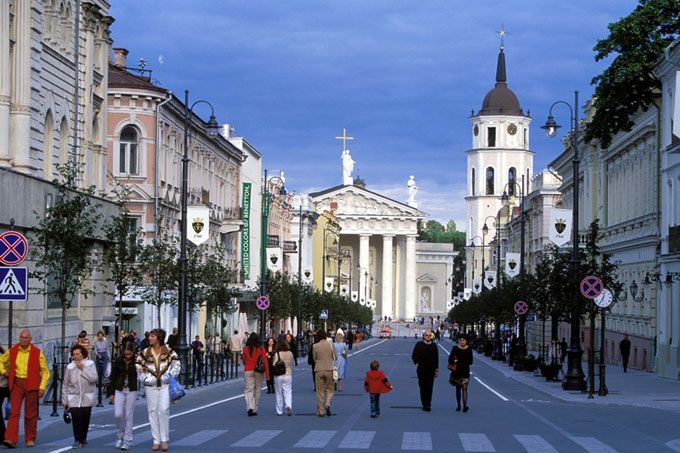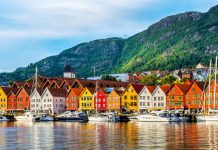Lithuanians, the last pagan nation in Europe, have never fully let go of their belief in supernatural powers all around them. Therefore, Lithuania’s national tourism development agency has created a map detailing over fifty magical objects—sculptures, monuments, and places—scattered all over the country, each with wish-granting properties and a magical story of its own.
Lithuania Travel, the national tourism development agency, has rolled out a map of over 50 magical places that will take visitors across the entire country—from the country’s capital to the Baltic shorelines when the travel restrictions are lifted. Meanwhile, miracle-seekers are welcome to travel virtually and add the magic objects to their wish lists for the time being.
The magical objects come in sculptures and monuments of all forms and shapes: animals, people, symbolic structures, or household items, and are said to grant wishes from the lifetime of happiness to courage and confidence. While some of the magical sculptures require rubbing or touching them, others promise to grant the wishes only after completing a task such as spinning around oneself a number of times, climbing the stairs without looking back, etc.
Lithuanians, still deeply connected to their pagan roots, are said to have a special affinity to such magic rituals. Here is a list of ten of the most popular magical objects that might grant all sorts of wishes to the visitors in Lithuania.
- The Miracle Tile. The Miracle Tile is a legendary tile in the Old Town of Vilnius, the capital of Lithuania, with the inscription that says Stebuklas (Miracle). Visitors walking by the Cathedral Square need to stop on the tile by the bell tower and make a wish. Although the artist created the tile with symbolic meaning in mind, people gave free rein to their imagination and attached different rituals to it: some believe the tile will grant the wish if a person spins around himself when standing on it, others say one needs to jump up and down for the miracle to happen. One thing is for sure: the artist’s vision has become a grain of hope for all of the believers.
- The Monument Beacon of Happiness. Those who are willing to work for their wishes should climb the hill of the Monument Beacon of Happinessin Anykščiai, a city in the Highlands Region. It is a grave of the well-known Lithuanian writer Jonas Biliūnas who was the one to create the fairy-tale “The Beacon of Happiness”—it said that happiness will be awarded for those who succeed to reach the top of the hill without looking behind them, while climbers who turn around will become stones. The symbolic meaning of the fairy-tale made all visitors believe their wishes will also be granted if only they climb to the top without ever looking back.
- The Witch. A witch sculpture with breasts of different sizes and an owl on her shoulder stands on the Witches Hill in Juodkrantė, a town in the Curonian Spit. It is believed that the sculpture grants success by providing the visitor with a child of the desired sex.
- The Cat.“Rub my ear and gone is the fear,” whispers the sculpture of a chubby cat with an earring, standing on the fence of “v2o” Jewelry Home in one of the squares of Užupis―the oldest and the most prestigious district in Vilnius and a self-proclaimed Republic of Artists with its own Constitution, hymn, and president. The story behind the sculpture tells about a cat which asked the jewelers of Užupis District to make an earring with its entire wisdom engraved in it. Since cats rule the District, even Article 13 of the Constitution of the legendary Republic of Užupis declares that “a cat is not obliged to love its owner, but must help in time of need” so the sculpture promises to grant wishes and eliminate fear for anyone who dares to touch its ear.
- The Tail of a Donkey.People who are tired of failing and hearing about their mistakes need to travel to Alytus, the largest city in Southern Lithuania. It is said that stroking the tail of a donkey which belonged to Hodja Nasreddin, Turkey’s well-known trickster, gives you a boost of confidence. According to the legend, when Nasreddin was asked why he was riding the donkey sitting backwards, he said that it was the donkey that was looking the wrong way.
- The Lucky Belly.Visitors who wish to attract success should look for a 40 cm diameter bronze bas-relief of a belly in the Lithuanian capital’s center. The piece of art is located on the wall of “Novotel Vilnius Center” hotel. It depicts a fragment of a chubby male belly tied with a ribbon. The magical powers of the sculpture originated from an old legend about the 19th century Vilnius Mayor who once visited a poor family with two successful sons—a merchant and a jeweler. When asked about the success of her sons, the mother told the Mayor she used to caress the merchant’s belly and the jeweler’s hands, saying “only caressed things can grow.” So now one needs to rub the belly if they want their business to succeed.
- The Detective.The sculpture was unveiled on Criminal Police Day to commemorate the officers of the criminal police and their usually invisible yet vital duty. Like many sculptures in Klaipėda, the country’s port town, this one has a secret too. The cloak of the detective has a hidden badge that brings peace and success.
- The Tree of Keys. Some consider ash to be a tree of men. Men are encouraged to visit the Tree of Keysin Panevėžys, the fifth largest city in Lithuania, and ask for their wishes to come true. One needs only to touch the tree, and Gauseklis—the mythological Santa—will take care of the rest. The story behind the keys on the tree is also unique—a box with seventy keys was found buried next to the tree. The Lithuanian forefathers believed the keys hold a symbolic meaning—when hung on the wall, they become protective charms. This part of the legendary tree also attracts the newlyweds who now hang keys in the hopes of ensuring their future success.
- The Clogs.Plungė, a city in Northwest Lithuania, has bronze clogs that symbolize the city’s never-ending love for folk dance. There are symbols inscribed all over the clogs, and one of them is the coat of arms of the city. People say―if you touch it, you are bound to return to the city once again.
- The Cow.The country’s biggest sinkhole Cow’s Cave in Biržai District has a statue of a cow which has a magical udder―if visitors want to make all of their wishes come true, all they have to do is rub the udder and hope for the best.
All of the wish-granting objects allow the visitors to discover small miracles in various corners of Lithuania. As reflected by “Real is Beautiful” trademark created by Lithuania Travel, the true beauty of such objects goes back to the deeply ingrained Lithuanian belief that everyday magic surrounds one at all times, hidden in the most unusual objects, and all wishes just might come true if you believe hard enough.


























